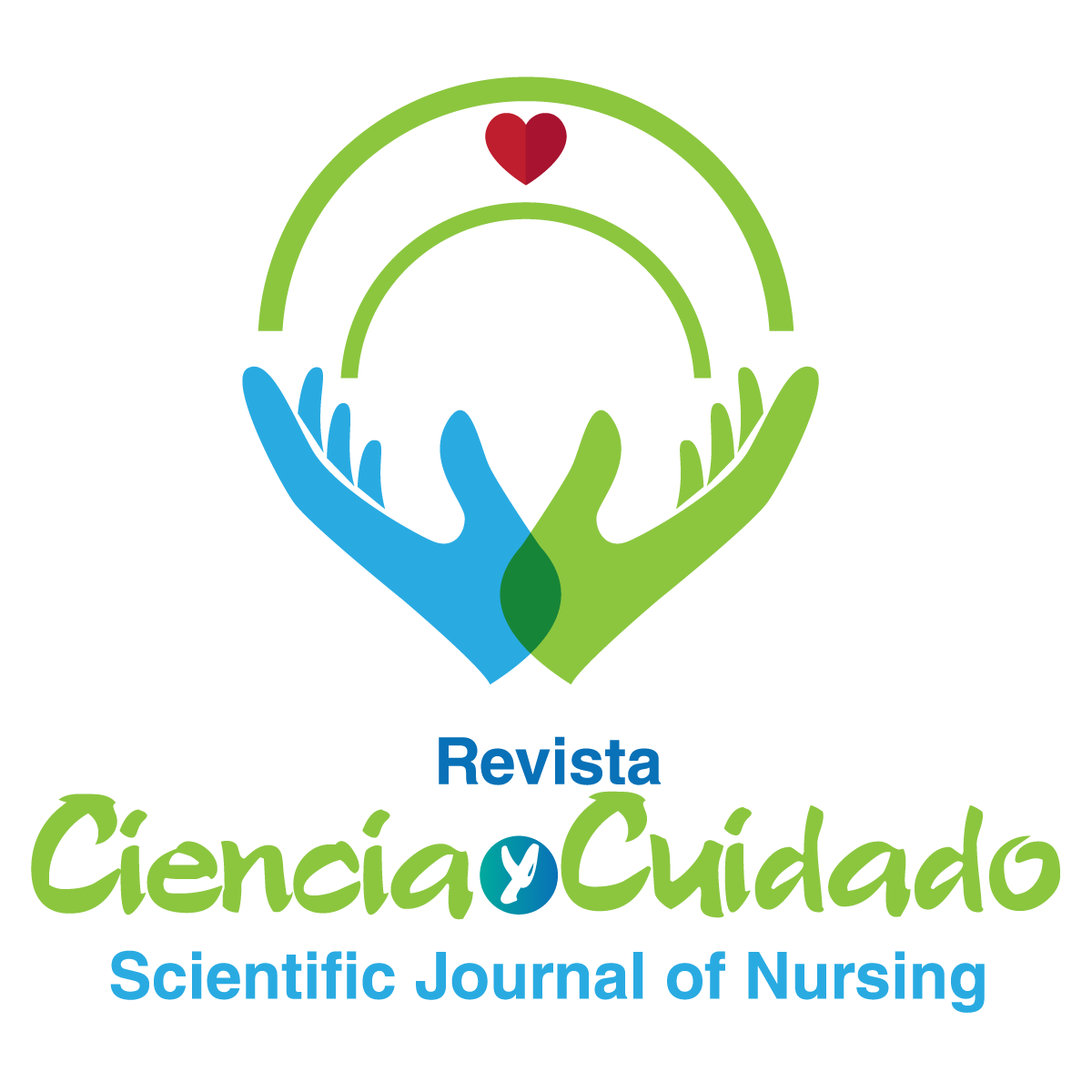

Articulo Original
Phenomenology of consumption of psycoactive substances in university students in Bogota.
Fenomenología del consumo de sustancias psicoactivas en estudiantes universitarios en Bogotá
Fenomenología do consumo de substâncias psicoativas nos estudantes universitários em Bogotá
Sandra Catalina Guerrero-Aragón1
Ángel Alberto García-Perdomo2
Sandra Milena Hernández-Zambrano3
Ruth Alexandra Castiblanco-Montañez4
Autor de correspondencia:
1* Surgical instrument technician, psychologist, specialization in university teaching. Master in neuropsychology and education. Research coordinator and professor. University Foundation of Health Sciences (FUCS). Bogotá, Colombia. sandra.guerrero@fucsalud.edu.co  0000-0003-0267-4124.
0000-0003-0267-4124.
2 Surgical instrument technician, specialization in Health management. Professor. University Foundation of Health Sciences (FUCS). Bogotá, Colombia. aagarcia@fucsalud.edu.co  0000-0002-4649-7046.
0000-0002-4649-7046.
3 Nurse, Master’s degree on health care for the promotion of autonomy in people and care in the processes at the end of life stage Doctor in health sciences. Research professor. University Foundation of Health Sciences (FUCS). Bogotá, Colombia.smhernandez3@fucsalud.edu.co  0000-0001-5504-3065
0000-0001-5504-3065
4 Nurse, master’s degree on public health. PhD student on health sciences. Research coordinator and professor. University Foundation of Health Sciences (FUCS). Bogotá, Colombia.racastiblanco@fucsalud.edu.co  0000-0001-8328-9601
0000-0001-8328-9601
© Universidad Francisco de Paula Santander. Este es un artículo bajo la licencia CC-BY-NC-ND
Recibido: 08 november 2019.
Aprobado: 03 april 2020.
 10.22463/17949831.1870
10.22463/17949831.1870
Abstract
Objective: Determine the phenomenological context related to the habits of consumption of psychoactive drugs, in university students from a higher education institution of health sciences in Bogota, Colombia. Materials and methods: Qualitative descriptive study of phenomenological approach; 8 interviews were performed in young university students (key informants) who knew about the university context, the dealers, and the consumers. The technique for the recollection of data used were in-depth interviews. The project was approved by the Research Ethics Committee in Human Beings, Hospital of San Jose – University Foundation of Health Sciences (FUCS). Results: The findings identify 6 categories: 1) Risk factors of polydrug abuse; 2) Protective factors of polydrug abuse; 3) Psychoactive drugs; 4) Places for consumption; 5) Risk behaviors; 6) Consumption effects. From the analysis of the content and the propositions, 14 sub-categories emerged: internal and external risk factors; external protective factors; support networks; illicit and legal drugs; places: bars, trips, friend’s houses; risk behaviors: suicide, fights, sexual risk behavior; mental and physical diseases and academic performance. Conclusion: The study concludes that the present social problematic in university students, is based on risk situations to which students are socially exposed and requires a formative process that starts during childhood. The UNODC, proposes to examine the variables that influence the consumption and act with viable preventive programs in depth, allowing to strengthen the intrapersonal and interpersonal skills.
Keywords:Neoplasm; emotions; pediatrics; nursing.
Resumen
Objetivo: Objetivo: Determinar el contexto fenomenológico en relación a los hábitos de consumo de sustancias psicoactivas, en estudiantes universitarios de una institución de educación superior de ciencias de la salud en Bogotá. Materiales y métodos: Estudio cualitativo descriptivo de enfoque fenomenológico; se realizaron 8 entrevistas a jóvenes universitarios (informantes clave) que conocían el contexto universitario, las personas expendedoras y las consumidoras. La técnica de recolección de datos fue con entrevistas a profundad. El proyecto fue aprobado por el comité de ética de investigación en Seres Humanos, Hospital de San José - FUCS. Resultados: Los hallazgos identifican 6 categorías: 1) Factores de riesgo de policonsumo; 2) Factores de protección de policonsumo; 3) Sustancias psicoactivas; 4) Lugares de consumo; 5) Conductas de riesgo; 6) Efecto del consumo. A partir del análisis de contenido y de las proposiciones emergieron 14 subcategorías: factores de riesgo internos y externos; factores de protección externos; redes de apoyo; sustancias lícitas e ilícitas; lugares: bares, viajes, casa de amigos; conductas de riesgo: suicidio, riñas, conductas sexuales de riesgo, enfermedad física y mental y rendimiento académico. Conclusión: en el estudio se concluye que la problemática social presente en los estudiantes universitarios, está fundamentada en las situaciones de riesgos a las cuales están expuestos socialmente y que requiere de un pilar formativo desde la niñez. La UNODC, propone examinar a profundidad las variables que influyen en el consumo y actuar con programas preventivos viables, que permitan fortalecer las habilidades intrapersonales e interpersonales.
Palabras Clave:Estudiantes del área de la salud; consumo de bebidas alcohólicas; consumo de alcohol en la universidad; uso de tabaco.
Resumo
Objetivo: Determinar o contexto fenomenológico em relação aos hábitos de consumo de substâncias psicoativas, em estudantes universitários de uma faculdade de ciências da saúde em Bogotá. Materiais e métodos: Estudo qualitativo descritivo fenomenológico; realizaram-se 8 entrevistas a jovens universitários (informantes chave) que conheciam o contexto universitário, as pessoas fornecedoras e as consumidoras. A técnica de recolecção de dados foi com entrevistas a profundidade. O projeto foi aprovado pelo comité de ética em pesquisa em seres humanos do Hospital de San José-FUCS. Resultados: Os achados identificaram 6 categorias: 1) fatores de risco de policonsumo; 2) fatores de proteção policonsumo; 3) substâncias psicoativas; 4) lugares de consumo; 5) condutas de risco; 6) efeito do consumo. Partindo da análise de conteúdo e das proposições surgiram14 subcategorias: fatores de risco internos e externos; fatores de proteção externos; redes de apoio; substâncias lícitas e ilícitas; lugares: bares, viagens, casa dos amigos; condutas de risco: suicídio, brigas, condutas sexuais de risco, doença física e mental y finalmente, rendimento acadêmico. Conclusão: A problemática social presente nos estudantes universitários, está fundamentada nas situações de risco, as quais estão expostos socialmente e precisam de uma formação estrutural desde a infância. A UNODC propõe examinar a profundidade das variáveis que influenciam o consumo e atuar com programas de prevenção viáveis, permitindo o fortalecimento de habilidades intrapessoais e interpessoais.
Palavras-chave: Estudantes na área da saúde; consumo de álcool; consumo de álcool na universidade; consumo de tabaco.
Introduction
Currently in Colombia, one of the problems faced by youth is the phenomenon of consumption and simultaneous consumption (polydrug abuse) of psychoactive drugs, especially in young college students; and is present, more frequently, in the higher education programs of health sciences in Latin America (1). According to the World Health Organization (WHO), psychoactive drugs are known as drugs that modify the conscience, the mood and the thought processes of an individual; also making the individual susceptible to create psychological and/or physical dependence (2). Thus, consumption of psychoactive drugs affects cognitive activities, that allow a person to take the adequate health and human development decisions; also affecting social abilities that facilitate the resolution of problems, assertive communication, and the control of thoughts and emotions (3). Similarly, the own aspects of human development of this age group is characterized by the search of new experiences and acceptation from pairs, generating new situations where they can access to more substances, allowing them to potentialize the effect; these experiences entail simultaneous consumption (polydrug abuse), which consists on the administration of a natural or synthetic substance orally, injected, smoked or absorbed, impacting the individual and social life of the young person (4).
study about the use of psychoactive drugs made in Andean states, including Colombia, shows that for the year 2016, 70% of the university students consumed alcohol in the last year, 17.2% cigarettes, 16.1% electronic cigarettes, 66.5% used only one substance and 33.5% more than one substance; the combined use of substances is noticeable, except for lysergic acid diethylamide (LSD) and cocaine, since young students consider these substances as exclusive use drugs (5). In the epidemiological study about the use of drugs in the university population, it is described that globally, consumption of alcohol and tobacco begins between the ages of 11 and 14; while teenagers from the age of 15 begin consuming illicit substances such as marihuana and other hallucinogens (6). Another study performed in an university with undergraduate students from the health sciences department, shows that the beginning of consumption is explained for the search of new experiences; as well as, perceiving greater independence and opposition in reference to adults and parental control, factors that have repercussions of higher risk of abuse/use of substances (7).The Colombian population has shown the frequent use of legal substances such as alcohol and cigarettes; however, at least 20% is in a risk situation or with problems related to abuse (8). Keith et al., (9) indicate that for the year 2018, the use of marihuana was frequent for students in the USA, pointing out that the use of marihuana in the last month was of 28.3% (323/1357), where, 10.2% consumed marihuana 1 to 2 days in the last month, 7.1% used it between 3 to 9 days, and 8.5% used this substance in less than 10 days. In Latin America, private and public universities offer an academic scenario, while also, through interaction with friends and schoolmates, there is frequent contact with legal psychoactive drugs such as alcohol and cigarettes, as well as contact with illegal substances such as marihuana and popper (10).
According to the established above, the consumption of psychoactive drugs could be present in young students in the form of experimental, social, regular, intense and compulsive experiences, implying consumption of more than two substances (polydrug use); this with the purpose of satisfying and maximizing the effect, parting from the quantity and type of substance, the frequency of how changes of physicochemical properties of the brain are generated, factors of personal vulnerability, family and social conditions that trigger addiction (11), as shown by studies of reference. Regarding the previous considerations, the present research work has as its objective to explore the phenomenon of consumption and simultaneous consumption of two or more psychoactive drugs (polydrug use) by young university students from a university in Bogota. To achieve the objective, in-depth interviews were used, which allowed to obtain key information regarding: psychosocial factors, the different people involved, places, and time of access and interaction with psychoactive drugs, inside and outside the university environment.
Materials and methods
A descriptive, qualitative study of phenomenological approach was made. This approach as argued by Husserl (12) is in charge of comprehending the perception of people and the interpretations of a particular situation or phenomenon, using recollection and analysis of data, to refine the research questions or reveal new questions in the process of interpretation. In that sense, the phenomenon related to the context in which the consumption of psychoactive drugs is developed was studied in-depth.
The population object of study was made up from undergraduate university students, from the health sciences programs, who were over the age of 18, and that were part of a higher education institution in Bogota, Colombia. The sampling was intentional. A total of eight participants were included due to saturation of information, who met the selection criteria of being key informants. They were chosen through observation from an ethnographic study that was made previously. Those who were denominated key informants knew the university context, frequented places where psychoactive drugs could be consumed and knew about dealers and consumers. The participants were adults of legal age and belonged to a private university of health sciences in Bogota, Colombia.
The technique for recollection of data was an in-depth interview; the instrument was based on the guide, which contained orientating questions to be asked during the interview; the interviews were done between December and January of 2019, with a duration of approximately 30 to 40 minutes.
The analysis of information was made in two stages: 1) the transformation, were each interview was transcribed; 2) protecting the information by omitting names and other elements that could allow the revelation of the identity of the participants. Next, a code was assigned to each participant (interviewer, interviewee, and witness). Subsequently, the subjects were identified, considering the most valuable segments of each interview through key words, organized by categories, to find similarities between the interviews and be able to establish an explaining synopsis, which allowed to connect the phenomenology of polydrug use with the student context. The categories were created in a database in Excel format 2016, to organize the data following the proposal of analysis of the content (13). Next, these categories were defined (proposition) according to their content, as proposed by Taylor (14), for their interpretation and the codification of the interview was made. Lastly, an interpretation with the respective methodological rigor was made through saturation; meaning, trying to find simultaneous coincidences of the interviews to achieve triangulation, credibility and description of the context.
The study was theoretically based on the Colombian health ministry resolution 8430 of 1993. For the execution of this study, the privacy and confidentiality of the interviewed participants was maintained through the application of an informed consent and treatment of data. The project was approved by the San Jose- FUCS Research Ethics Committee on human beings (CEISH).
Results
The result of the eight in-depth interviews made to the key informants from the FUCS, with an age range from 19 to 21 years, where the female gender predominated, determined that the participants have good family relationships with their immediate family, and belong to a social stratus ranging between 2 and 4. All the participants lived in Bogota and were currently studying in the undergraduate programs of surgical instrument technicians and nursing. Similarly, they manifest their consumption patterns, giving as a result the categories that allowed to study in-depth this phenomenon. The results were structured in six categories through the analysis of the content and the propositions: risk factors of polydrug use, protective factors of polydrug use, psychoactive drugs, places for consumption, risk behaviors and effects of consumption. Considering all the categories mentioned, 14 sub-categories emerged (Figure 1).
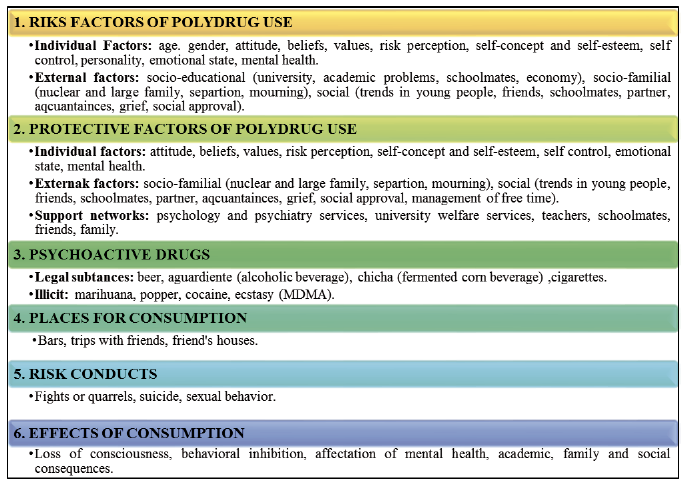 Figure 1. Findings from the categories and subcategories that emerged from the phenomenon of polydrug abuse in young university students.
Source: Authors (2019).
Figure 1. Findings from the categories and subcategories that emerged from the phenomenon of polydrug abuse in young university students.
Source: Authors (2019).
internal and/or external characteristic of the individual (young university students), their presence increases the probability or predisposition of producing the phenomenon of use and abuse of psychoactive drugs. On this matter, the participants spontaneously narrate their activities and describe their interpersonal and social relationships. Almost all participants agreed on categorizing their group of friends in function to their personal and cultural identity, and their interests. In the same way, the participants point out the motivations that take them to consume psychoactive drugs, both in their personal and their external life.
Table 1. Categories and subcategories of the risk factors of polydrug abuse.
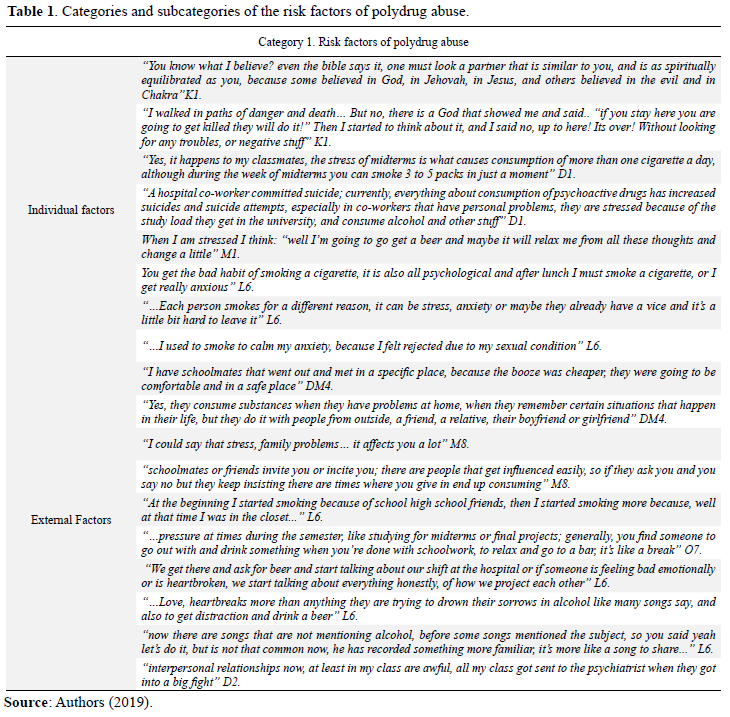 Source: Authors (2019).
Source: Authors (2019).
Category 2. Protective factors of polydrug use: these are individual attributes, current situations, environment or context that reduces the probability of use and abuse of psychoactive drugs. In this context, the ideal is to change plans for trips to places of social interest and not for consumption of substances, like going around the city and seeing new places or identifying touristic places. Also, consumption has to be recognized as a problematic factor that affects family relationships; as well as identifying how the consumption of psychoactive drugs affect the health of an individual, and the sequels in their physical and mental state.
Table 2. Categories and subcategories of the protective factors for polydrug use
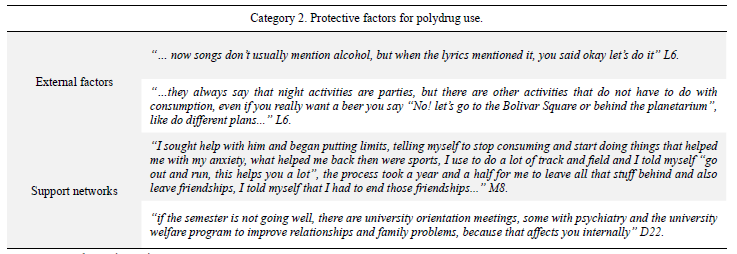 Source: Authors (2019).
Source: Authors (2019).
Category 3. Consumption of substances: these are substances of natural or artificial origin that affect the functions of the central nervous system (CNS), conditioning the probability of use and abuse of psychoactive drugs to occur. Consumption of alcoholic substances such as beer, is a precursor of the use of psychoactive drugs; an activity that occurs when people want to share the same social, personal or academic interests with other people. Also, talking about any subject while drinking alcoholic beverages, can lead a person to express or tell what is happening on their day to day. Marihuana is considered an illicit drug that by general rule, within the university context, is used by students between classes; however, the purpose of this practice is not mentioned. In addition, alcoholic beverages such as chicha, are consumed by young university students in places nearby the campus, which makes it more accessible for them.
Table 3. Categories and subcategories for psychoactive drugs and places for consumption,
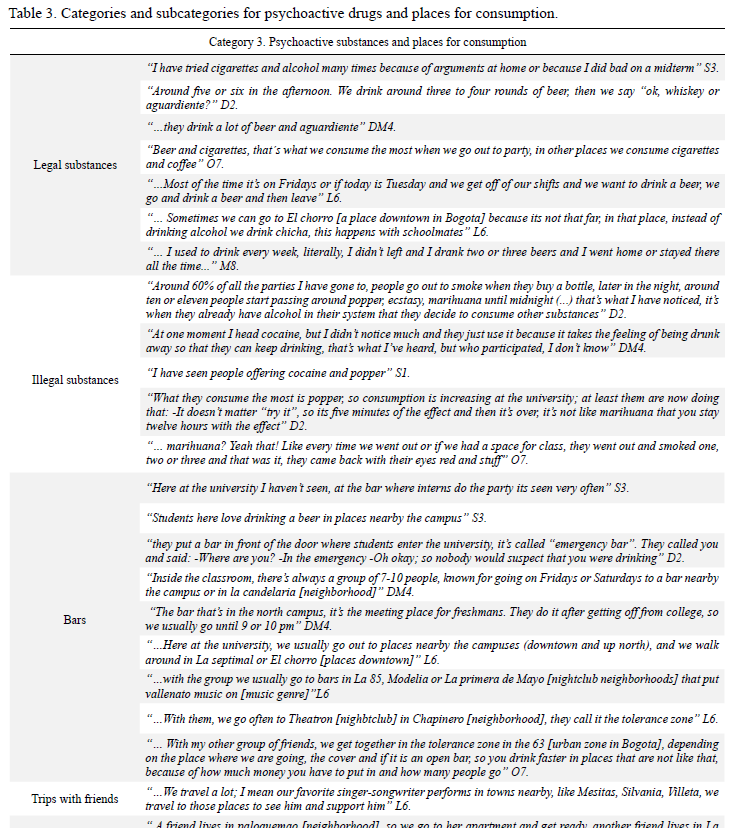 Source: Authors (2019).
Source: Authors (2019).
Category 4. Frequented places: these are places where use and abuse of psychoactive drugs is practiced. These places are frequented and accessible since they are close to the university campus. It must be mentioned that these activities modify behaviors on a personal, emotional and sentimental level, making it a factor that can increase consumption.
Category 5. Risk behavior: this is the behavioral effect caused after being exposed to the use and abuse of psychoactive drugs, which generates an ambiguous attitude in the young university students. On an individual level, students are more sensitive to side effects related to changes in their mood, which can improve (euphoria) or worsen (sadness); similarly, it can cause drowsiness, slowness or increase of energy. These effects are a risk for the health of the students and for society. These attitudes can also increase the risk of having sexual relationships without using protection, unwanted pregnancies, fights triggered by violence and loss of reasoning.
Regarding the effects of consumption: these are the consequence of combining substances to increase certain pleasures; however, at the same time it multiplies the harmful effects, as it was observed and analyzed in each of the interviews.
Table 4. Category and subcategories of risk behaviors and effects of polydrug use.
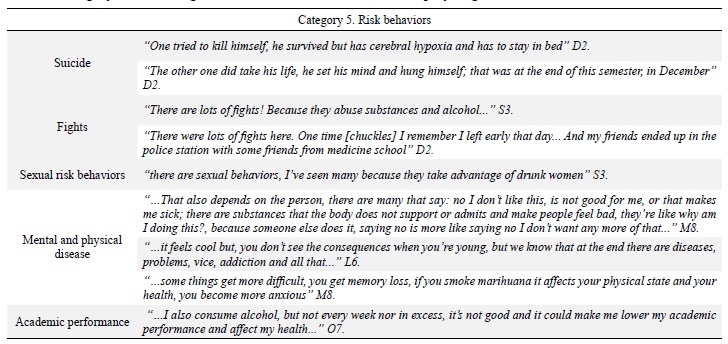 Source: Authors (2019).
Source: Authors (2019).
Discussion
The present research work was made from a qualitative approach of the phenomenological design, which allowed the analysis of the polydrug abuse phenomenon from the perspective of the university students. This allowed the study to comprehend which are the main internal and external factors that have an impact on the consumption of psychoactive drugs; as well as the patterns of consumption and risk behaviors, that make part of the context of the use and abuse of psychoactive drugs in young university students from a higher education institution in Bogota. Within the main findings the established categories were: 1) Risk factors of polydrug use; 2) Protective factors for polydrug use; 3) Psychoactive drugs; 4) Places for consumption; 5) Risk behaviors; and 6) Consumption effects, by analyzing their content and the propositions, considering that from all the categories mentioned, 14 subcategories emerged, described from the eight in-depth interviews, a technique that concurs with the work of Robles (12).
It can be noted that the findings identified in the main categories that affect polydrug use were relevant for the study, since these allowed to further examine the phenomenon of consumption in young university students. As external factors, mainly, family problems and interpersonal behaviors such as social pressure, acceptation, academic and family difficulties were detected; situations that stimulated the consumption of psychoactive drugs, alcohol abuse and other types of substances directly involved. The internal factors were related to age, personality and life experiences; circumstances that influence the behavior and their way of confronting situations, as well as taking decisions; these factors go along with the life cycle and the level of maturity of the person. In this sense, the municipal plan against drugs in Spain (15) indicates that external risk factors are present on the social, family, student community, sociocultural, and deviating behavior levels; as internal or intrapersonal factors, there are the personality and emotions of the person. Hernandez et al., (16), mention that risk factors related to polydrug use are associated to the family and social context of the young university students, since their research work demonstrates the correlation between consumption and access to drugs by close friends or relatives. The abovementioned coincides with the findings of this study, since the phenomenon of consumption and polydrug use is triggered by the incentives of family, partners, schoolmates and friends. Also, it is related to the current personal, academic and family situation. It must be noted that all the aspects, previously mentioned, influence in the assertive and unassertive resolution and confrontation decisions of the young person.
Regarding the protective factors, the external factors that could protect young students must be considered, these can be: music that does not encourage the consumption of substances and risk sexual behaviors; managing free time and nearby places that encourage activities different to consumption of substances. Also, students could be referred to support networks through schoolmates, family, professors and close friends, allowing them to give difficult situations present in their lives a different meaning. Paya and Castellano (17) mention that intrapersonal factors such as self-esteem and self-concept that are structured since childhood, become a basic pillar for protection; similarly, mentioning that on the family level, it is of vital importance to establish rules, limits, responsible love and education, and choosing friends, since these factors could strengthen the psychosocial development and the beginning of independence of the young person. The Health Ministry (18) suggests that, within the prevention of consumption of psychoactive drugs, the development of individual skills such as empathy, social abilities and the ability of confronting problems should be considered as protective factors. In regard to the family factor, it suggests strengthening the family ties through respect, trust, and rules of the house. On the other hand, the social factor advises to stimulate participation in community and sport activities and managing free time. Although the informants do not emphasize on protective factors for consumption of psychoactive drugs, it should be considered that some of the results coincide with the previously mentioned authors, regarding adequate use of free time and family support to prevent use and abuse of psychoactive drugs. In that sense, the findings of the study are relevant, since they allow the planning of intervention strategies on the individual, social and family levels that contribute to the prevention of consumption of substances.
The results of the type of substance consumed by young university students vary between beer, cigarettes, aguardiente, marihuana, chicha, popper, cocaine and ecstasy. Cordoba-Paz et al., (19) suggest in their study about consumption of psychoactive drugs at the university level, that young people frequently consume marihuana, cocaine and acid, giving preference to the simultaneous consumption of one of these substances with alcohol. For their part, Cazenave and Saavedra (20) emphasize that the use of marihuana is noticeable in some young students, where the social rules established by a group of schoolmates, which are created at the beginning of the university stage, directly influences on consumption. Diaz-Castela et al., (21) express that university students consume alcohol more frequently, but it is concerning and elevated the incidence of consumption of other drugs such as cannabis, cocaine and ecstasy. According to the present study, a relationship is shown between consumed substances by university students and other research works. As a consequence, this demonstrates the importance of responding to risk situations that could encourage students not only to consumption, but also to polydrug use, in function to experiencing new emotions and pleasurable sensations; likewise, the personal and social situations that put them at risk must be considered.
It is convenient to clarify the places identified in the study where consumption and polydrug use occurs more frequently, which were obtained through the in-depth interviews. These are: nightclubs and bars, friend’s houses and places nearby the school campus. Zambrano et al., (22) mention that the preferred places for students are nightclubs, bars, and friend’s houses. This demonstrates that family and friends, provide places for consumption and set up spaces for socialization and free time such as bars, where it is easier to be in contact with people who encourage the massive consumption of psychoactive drugs. Also, the interviews show that the participants are usually immersed in different risk situations such as: fights, risky sexual behaviors, suicide and aggressiveness. These attitudes concur with a study made by Castano-Perez and Calderon-Vallejo (23) where they emphasize that the problematics derived from consumption in young university students are fights, risk sexual behaviors and self-aggressive behaviors. It is worth mentioning that risk behaviors related to consumption of psychoactive drugs, as established by Vasquez et al., (24) occur when driving an automobile or motorcycle under the influence of a substance, which leads to fights, accidents and low academic performance. The mentioned evidence indicate that from places and risk situations, the management of free time, choosing friends and different intrapersonal and interpersonal circumstances are derived, leading the young person to develop behaviors of scarce self-care, which can lead to sexually transmitted diseases, and physical and mental consequences caused by fighting and accidents; also, a progressive deterioration is present, manifested by consumption, inadequate eating habits, and low emotional regulation, affecting the quality of life of the young person.
Regarding the effects derived from consumption, the effects that outstand in the study are those related to physical and mental consequences and the academic performance, as shown by the interviews. Chavarria and Segura (25) indicate that the effects are caused by changes of behavior, evidenced by low emotional regulation, low self-control and behavioral inhibition. In that sense, the UNODC (26) helps countries to implement practices, according to the international standards on drug use prevention, according to this organization, people that use certain types of drugs, as is the case of injectable drugs, can generate multiple consequences for health; as well as being at a higher risk of overdose and transmitted blood diseases or infections such as HIV and hepatitis C. Similarly, the relationship between consumption and low emotional regulation should be considered, as well as mental health problems. These aspects can have an impact on anxiety, sleep disorders and disruptive behaviors such as: impulsiveness, aggressiveness, fights and uninhibited behaviors, which leads to suggest intervention in primary intervention from education, this way socializing the effects and consequences, as a way of generating impact in the student community (27).
Accordingly, the phenomenological study manifests the present social problematic in university students, based on risk situations to which young university students are socially exposed to and require a basic pillar starting during childhood, allowing the sustainability and assertive decision-making at the time of going to university. Is worth mentioning that according to a study about values and beliefs on young people in regard to polydrug use of addictive substances, young people can be affected in some intrapersonal aspects related to: personality, emotional intelligence and low emotional intelligence (28); also affecting the physical and psychosocial aspects. On the other hand, it is important to clarify that an early onset of drug consumption, is a predictor of future psychosocial and abuse of substances problems, which leads the young person to show signs of depression, anxiety, low emotional regulation, low self-control and behavioral uninhibition , that adding up to family, economic and academic difficulties, incentivizing the person to start using legal or illegal substances (28, 29). Therefore, it is of vital importance to examine in-depth the variables that influence consumption; from this, preventing programs that are able to modify and strengthen life skills and emotional responses in young people should be implemented, with the purpose of generating protective factors that lower the risk of consumption. This is related to the strong trend around young university students of consuming substances in social situations with the expectation of lowering the psychological tension (30). Thus, it is relevant to determine the psychological consequences of polydrug use in the areas of personal, family, social and academic adjustment. It should be noted that the participants did not deny giving their perception and describing the situations and experiences of a third party who consumes psychoactive drugs; hence, the obtained information becomes a reference and starting point to look into the most adequate and pertinent strategy to orientate university students.
Within the limitations of the study, since it is a qualitative descriptive study, it is important to be careful with the transferability of the results; this can make difficult to select the key informants to be able to generate the necessary trust in them to provide personal information about this phenomenon, which is currently present in the student community of the health areas, affecting the human and professional development of the consumer.
Conclusions
The findings allow the authors to conclude that polydrug use is a phenomenon of social and multifactorial origin, considering that some factors associated are given at the personal, family, social, and academic levels; therefore, a directed intervention must be implemented to strengthen the intrapersonal abilities and life skills, allowing to generate support for the person, lowering the vulnerability towards the use and abuse of psychoactive drugs. From this perspective, peer strategies must be implemented, allowing an effective approach to the young person; also, support networks should be consolidated with the purpose of allowing to establish a life pathway and managing situations that are present in university students. Similarly, teachers must be prepared for situations different to academic situations, allowing them to become guides to mitigate risk and consumption situations for the students.
Agradecimientos
The present research is dedicated to the students Alejo Fiesco, Luisa Fernanda, Barrera Vargas Angie Paola, Valencia Marin Maria Paula, Quintero Angarita Vanessa, Lozada Velasco Yeni Maritza, Castro Ayala Laura Nataly, Torres Amaya Lina Maria, Angelica Maria Tijaro Aguilar, Jose Luis Hernández Morales, Rosa Lizeth Clavijo Rodriguez, Yenifer Andrea Ceballes Pajoy, Cindy Lorena Ramírez Grajales y Cristian Felipe Daza Caro, whom participated in the recolection of data, and made part of this research.
Declaration of conflicts
The authors declare not having any conflict of interests.
Bibliographic references
1. Zambrano S, Bastidas L, Paz E. Consumo de alcohol en estudiantes universitarios colombianos. Universidad y salud [Internet]. 2017; 19 (1): 37-50. [Citado 2019 mayo 15]. Disponible en: http://www.scielo.org.co/pdf/reus/v19n1/0124-7107-reus-19-01-00037.pdf
2.González B. Policonsumo de sustancias psicoactivas [Internet]. [Citado 2019 abril 25]. Disponible en: http://www.espolea.org/uploads/8/7/2/7/8727772/ddt-policonsumo.pdf
3.UNICEF. Habilidades para la vida, herramientas para el buen trato y la prevención de la violencia. [Internet]. 2014 [Citado 2019 sept. 10]. Disponible en: https://www.unicef.org/venezuela/spanish/Habilidades_ Correcciones_Noviembre.pdf
4.Espinosa T. Estructura de las prácticas de consumo de sustancias psicoactivas en un grupo de universitarios. [Tesis Doctoral]. 2016 [Citado 2019 sept. 11]. Disponible en: http://biblioteca.clacso.edu.ar/Colombia/ alianza-cinde-umz/20170327051558/GretelEspinosaHerrera.pdf
5. UNODC. III Estudio epidemiológico andino sobre consumo de drogas en la población universitaria, Informe Regional, 2016. [Internet]. 2017 [Citado 2019 sept. 10]. Disponible en: https://www.unodc.org/documents/ colombia/2017/Octubre/Informe_Universitario_Regional.pdf
6. Espinosa H, Castellanos O, Osorio D. Condición juvenil y drogas en universitarios: El caso de una universidad regional. Revista Latinoamericana de Ciencias Sociales, Niñez y Juventud [Internet]. 2015. [Fecha de consulta 25 de abril del 2019]; 14 (2), pp. 1451-1468. Disponible en: http://www.scielo.org.co/pdf/rlcs/v14n2/v14n2a39.pdf
7.Silva R, Simich L, Strike C, Brands B, Giesbretch N, Khenti A. Diversidad y complejidad en el fenómeno de las drogas: El Policonsumo simultáneo en estudiantes universitarios, Cundinamarca-Colombia. [Internet]. 2012. [Fecha de consulta 25 de abril del 2019]; 21 (Esp): 49-55. Disponible en: http://www.scielo.br/pdf/tce/v21nspe/v21nspea06.pdf
8. Cogollo-Milanés Z, Arrieta-Vergara KM, Blanco-Bayuelo S, Ramos-Martínez L, Zapata K, Rodríguez- Berrio Y. Factores psicosociales asociados al consumo de sustancias en estudiantes de una universidad pública. Rev Salud Pública. 2011; 13:470–9
9. Keith D, Hart C, McNeil M, Silver R, Goodwin, R. Frequent marijuana use, binge drinking and mental health problems among undergraduates. [Internet] 2015. [Accessed 20 Apr. 2018] US National Library of Medicine National Institutes of Health. Disponible en: https://www.ncbi.nlm.nih.gov/pmc/articles/PMC4551615/
10.Prevalencia y factores de riesgo para el consumo y dependencia de drogas en estudiantes de una universidad de Medellín, Colombia, 2009. [Internet]. 2009. [Citado 2019 abril 25]. Disponible en: http://www.redalyc.org/pdf/120/12023071005.pdf
11. Cáceres D, Salazar I, Valera M, Tovar J. Consumo de drogas en jóvenes universitarios y su relación de riesgo y protección con los factores psicosociales. Univ. Psychol. [Internet] 2006. [Fecha de consulta 25 de abril del 2019]; 5 (3). Disponible en: http://pepsic.bvsalud.org/scielo.php?script=sci_arttext&pid=S1657-92672006000300008
12. Izquierdo G, Rodríguez J. La fenomenología desde la perspectiva hermenéutica de Heidegger: una propuesta metodológica para la salud pública. [Internet]. 2015. [Citado 2019 abril 03]. Disponible en: http://www.scielo.org.co/pdf/rfnsp/v33n3/v33n3a14.pdf
13. Hernández R, Fernández C, Baptista P. Metodología de la investigación [Internet]. 6ta edición. México: McGraw Hill; 2014 [acceso 26 de marzo de 2018]. Disponible en: http://observatorio.epacartagena.gov.co/wp-content/uploads/2017/08/metodologia-de-la-investigacion-sexta-edicion.compressed.pdf
14. Taylor S, Bogdan R. Introducción a los métodos cualitativos de investigación. [Internet]. 1994. [Citado 2019 abril 03]. Disponible en: https://iessb.files.wordpress.com/2015/07/05_taylor_mc3a9todos.pdf
15. Navarro J. Factores de riesgo y protección de carácter social relacionados con el consumo de drogas. [Informe] 2000. [Citado 2019 nov. 5]. Disponible en: http://www.pnsd.mscbs.gob.es/profesionales/publicaciones/ catalogo/bibliotecaDigital/publicaciones/pdf/factores.pdf
16.Hernández-Serrano O, Font-Mayolas S, Gras ME. Policonsumo de drogas y su relación con el contexto familiar y social en jóvenes universitarios. [Internet] 2015 [Citado 2019 nov. 7]; adicciones, 27 (3). Disponible en: http://www.adicciones.es/index.php/adicciones/article/view/707
17. Payá B, Castellano G. Consumo de sustancias. Factores de riesgo y factores protectores. [Internet] 2014. [Citado 2019 nov. 9]. Disponible en: https://www.sepeap.org/wp-content/uploads/2014/02/Ps_ inf_consumo_sustancias_riesgo_factores_protectores.pdf
18. Minsalud. Prevención del consumo de sustancias psicoactivas (SPA). [Internet]. 2019 [Citado 2019 dic. 4]. Disponible en:
19. Córdoba-Paz EG, Betancourth-Zambrano S, Tacán-Bastidas, LE. Consumo de sustancias psicoactivas en una universidad privada de Pasto, Colombia. Psicogente, 20 (38): 308-319. http://doi.org/10.17081/ psico.20.38.2552
20Cazenave A. Saavedra W. Huerta P. Aguirre C. Consumo de marihuana en jóvenes universitarios: percepción de los pares. [Internet]. 2017. [Citado 2019 mayo 15]; Ciencia y enfermería, (1): 15-24. Disponible en: https://scielo.conicyt.cl/pdf/cienf/v23n1/0717-9553-cienf-23-01-00015.pdf
21. Díaz-Castela MdlM, Anguiano-Garrido B, Muela-Martínez JA. El consumo de drogas en el alumnado de la universidad de Jaén. Acción psicológica, 2016; 13 (1): 53-66. ISSN: 1578-908X http:// dx.doi.org/10.5944/ap.13.1.16723. Disponible en: http://scielo.isciii.es/pdf/acp/v13n1/1578-908Xacp-13-01-00053.pdf
22. Zambrano S, Bastidas L, Paz E. Consumo de alcohol en estudiantes universitarios colombianos. [Internet]. 2017. [Citado 2019 mayo 15]; Rev Univ. Salud. 2017; 19(1): 37-50. DOI: http://dx.doi.org/10.22267/ rus.171901.67 Disponible en: http://www.scielo.org.co/pdf/reus/v19n1/0124-7107-reus-19-01-00037.pdf
23.Castaño-Pérez GA, Calderón-Vallejo GA. Problemas asociados al consumo de alcohol en estudiantes universitarios. [Internet]. 2014. [Citado 2019 mayo 15]. Rev. Latino-Am. Enfermagem, sept.-oct. 2014; 22(5):739-46. DOI: 10.1590/0104-1169.3579.2475. Disponible en: http://www.scielo.br/pdf/ rlae/v22n5/es_0104-1169-rlae-22-05-00739.pdf
24.Vázquez Fernández ME, Muñoz Moreno MF, Fierro Urturic A, Alfaro González M, Rodríguez Carbajo ML, Rodríguez Molinero L. Consumo de sustancias adictivas en los adolescentes de 13 a 18 años y otras conductas de riesgo relacionadas. Rev Pediatr Aten Primaria, 2014; 16 (62). DOI: http://dx.doi. org/10.4321/S1139-76322014000300005. Disponible en: http://scielo.isciii.es/scielo.php?script=sci_arttext&pid=S1139-76322014000300005
25.Chavarriaga-Rios MC, Segura-Cardona AM. Consumo de sustancias psicoactivas y comportamientos violentos en estudiantes de 11 a 18 años. Itagüí, Colombia. Rev. salud pública, 2015; 17 (5): 655-666. Disponible en: http://www.scielo.org.co/pdf/rsap/v17n5/v17n5a01.pdf
26.UNODC. Informe mundial sobre drogas 2019. [Informe] 2019 [Citado 2019 dic 3]. Disponible en: https://wdr.unodc.org/wdr2019/prelaunch/WDR2019_B1_S.pdf
27.Hj N, Alavi M, Mehrinezhad S, Ahmadi A. Academic Stress and Self-Regulation among University Students in Malaysia: Mediator Role of Mindfulness. Behav Sci (Basel) [revista en Internet] 2018. [acceso 13 de marzo de 2019]; 15(8). Disponible en: https://catalogo.fucsalud.edu.co:2054/pmc/articles/PMC5791030/ https://catalogo.fucsalud.edu.co:2054/pmc/articles/PMC5791030/
28. Martín-Santana JD, Fernández-Monroy M, Galván-Sánchez I. Valores y creencias de los jóvenes ante el policonsumo de sustancias adictivas. Revista de Ciencias Sociales; 2015; XXI (4): 494 – 508.
29. Oteo-Pérez A. Tendencias en el consumo de drogas en la juventud española y efectos sobre su salud. Revista de Estudios de Juventud. 2009 mar; (84): 155-177.
30. Londoño C, García W, Valencia SC, Vinaccia S. Expectativas frente al consumo de alcohol en jóvenes universitarios colombianos. Anales de psicología. 2005; 21(2): 259-267.
Para citar este artículo / To reference this article / Para citar este artigo/
Guerrero-Aragón Sandra Catalina; García-Perdomo Ángel Alberto; Hernández-Zambrano Sandra Milena; Castiblanco-Montañez Ruth Alexandra. Phenomenology of con sumption of psycoactive substances in university students in Bogota. Rev. cienc. cuidad. 2020; 17(2): 53-64. https://doi.org/10.22463/17949831.1870
0000-0003-0267-4124.
0000-0002-4649-7046.
0000-0001-5504-3065
0000-0001-8328-9601